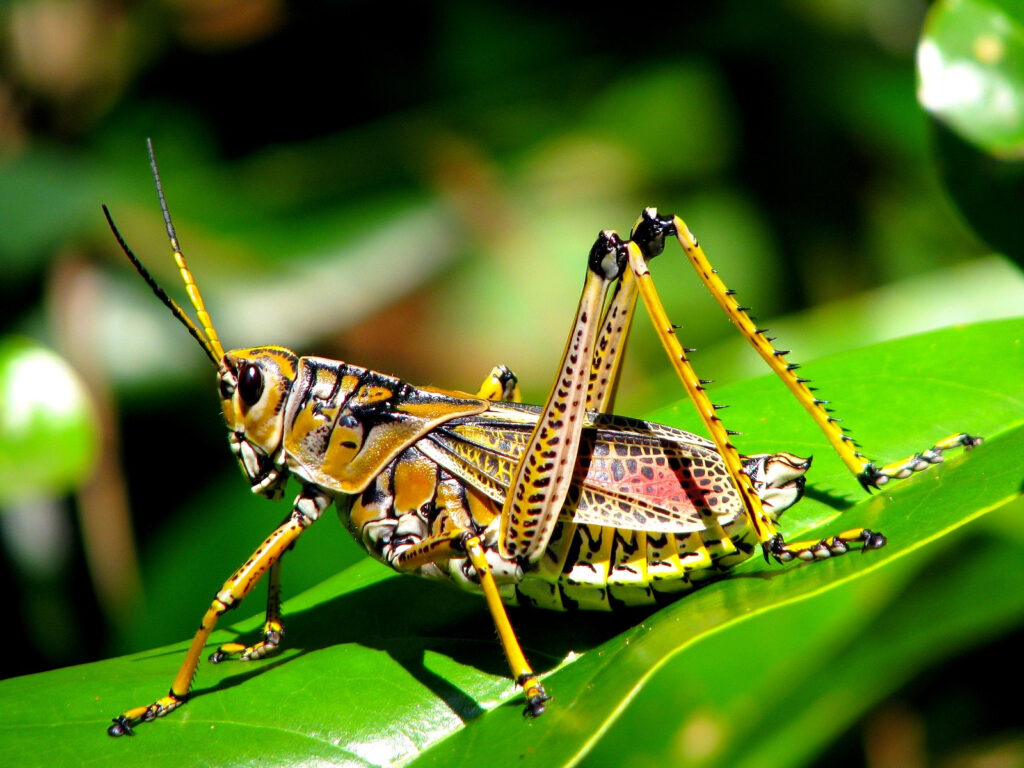
I’ve always found grasshoppers to be a real treat to watch. I’ve learned to observe them in the wild and how to take care of them. They are easy to care for, energetic, and can come in many different shapes and sizes. In Arizona, there are many grasshopper species. Grasshoppers are, in fact, one of the first insects that inspired me to take care of insects. Many people often mistake them with locusts (More on that later) but grasshoppers are unique and stand out to me as one of the most interesting insects to keep as pets and observe. Read on to learn more interesting grasshopper facts!
What Are Grasshoppers?
Grasshoppers are herbivorous insects that are in the suborder Caelifera (Latin for ‘chisel bearing’ due to the shape of its ovipositors on the end of its abdomen) which is in the main order of Orthoptera. Orthoptera means ‘straight winged’ coming from the Greek word orthós (straight) and pterá (wings).
Grasshopper or Locust?
Can you tell the difference between the grasshopper and the locust?
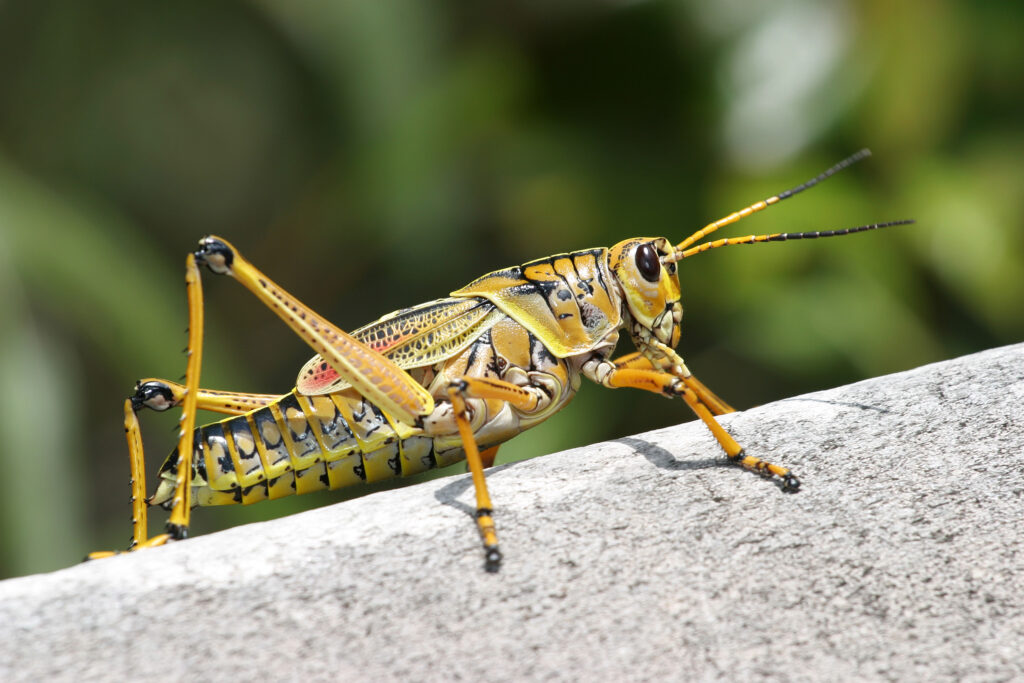

People may confuse the two terms ‘grasshopper’ and ‘locust’ but there are three key differences that you can use to spot the differences.
- Locusts engage in ‘swarm’ behavior and will assemble into a swarm of sometimes millions of bugs. Grasshoppers are solitary and only gather to mate.
- Locusts can migrate long distances, while grasshoppers do not.
- Locusts are generally larger than grasshoppers, but their overall body size, like their thorax and abdomen, is slimmer and not as bulky.
Grasshoppers and locusts are both in the same family, but while there are thousands of grasshopper species, there are only about 19 species of locust. Locusts can mostly be found in regions of Asia and Africa. One characteristic that can help you recognize if it is a locust or a grasshopper is its anatomy. Locusts typically have longer more sturdy wings, while grasshoppers have short wings.
Where Are Grasshoppers Located?

Grasshoppers are located on every continent except Antarctica. They can be found in deserts, mountains, plains, jungles, and forests. They are a vital part of any ecosystem since they are an excellent food source for insectivores and carnivores. Due to their hardy nature and ability to breed prolifically, they are considered pests to people due to their voracious appetite for vegetation, and some invasive species are affecting local ecosystems.
What do Grasshoppers Look Like

Grasshoppers are like all insects in that they have bodies divided into three main segments: head, thorax, and abdomen. Grasshopper heads are composed of their mandibles (their mouth, which they use to consume food) two compound eyes, and two antennae. Grasshoppers use their compound eyes to detect movement, shape, color, and distance. They also have three small ‘eyes’ called ocelli on their forehead that help detect light intensity. Their two antennae help detect smells and have touch receptors.
Grasshoppers have 6 legs. Their front legs are shorter so it can help them grasp objects. Then there are their back legs, which is what allows them to hop, hence their name ‘grasshopper’. These legs enable them to jump 20 times their length in a single hop. They will jump to escape predators, as a means of travel, and to help it achieve liftoff when it want to fly. Jumping is a great strategy against predators since it will startle or confuse them, which allows grasshoppers enough time to make an escape.
Grasshopper Facts About Adaptations
Grasshoppers come in many shapes, sizes, and colors. Many grasshoppers have developed specialized abilities. For example, some grasshoppers engage in stridulation. Stridulation is where they will rub certain body parts together to generate a sound, often a kind of chirping sound like crickets to attract females. Other grasshoppers will be able to produce stinky bad-tasting liquids to deter predators. Other grasshoppers will have bright colored patterns on their wings that will flash a bright color every time they extend them in order to fly or hop away. Many grasshoppers are brightly colored in order to warn predators they are toxic, even if they are not. Some species of grasshoppers are aposematic, which means that they are brightly colored, but are genuinely toxic to eat.
One of the things that stand out to me about grasshoppers is the variety of colors they can be, from bright red to inky black, I admire the diversity of colors that the species has and am eager to show off some of my favorites.
Do Grasshoppers Fly?
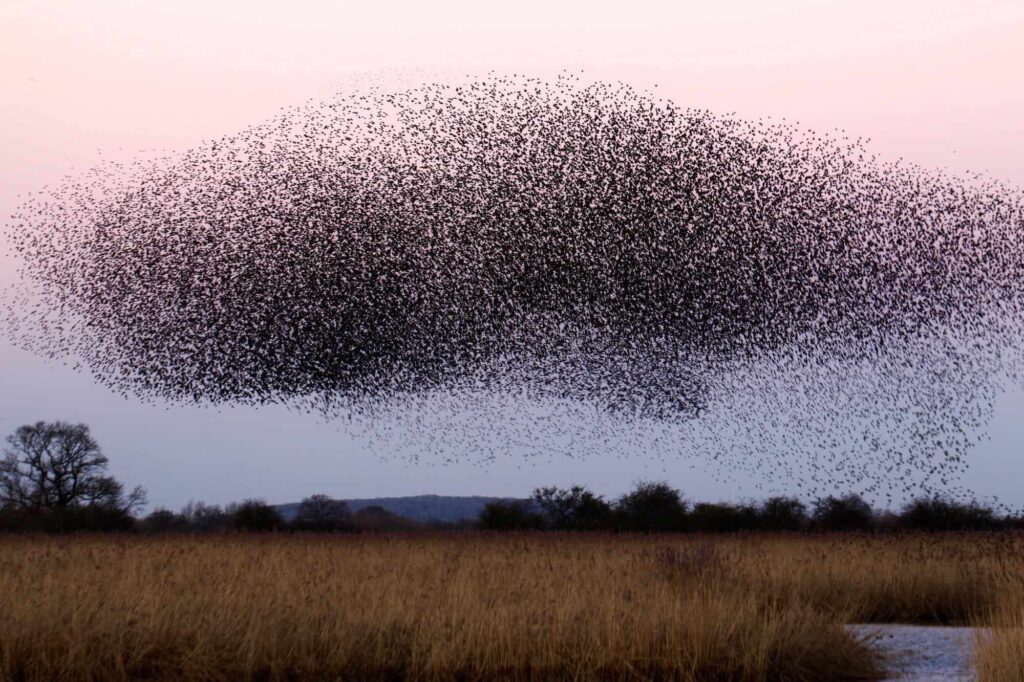
Some species of grasshoppers can fly, but only short distances. Some grasshopper species can’t fly at all and rely on hopping as their main mode of transportation. All species of locusts, which are in the grasshopper family, can fly. This enables locusts to cause massive damage to crops over large distances by being able to swarm and fly together.
My Top 5 Favorite Grasshopper Species
1. Eastern Lubber Grasshopper (Romalea Microptera)
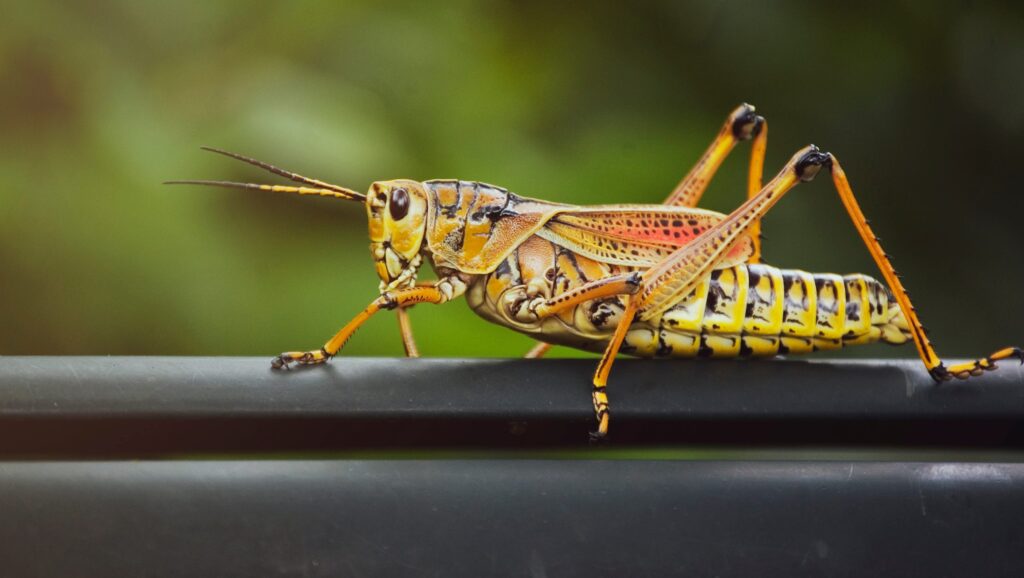
These bright-colored beauties also secret a foul-smelling, foamy spray if you bother it. This spray, if ingested, can make you sick. Eastern Lubber Grasshoppers live throughout Florida and from North Carolina to Tennessee, in Georgia, Alabama, Mississippi, Louisiana, Arkansas, Texas, and Arizona.
2. Ak Grasshopper (Poekilocerus Pictus)

This species is also known as the ‘aak grasshopper’ as well. These colorful critters can be found in India, Pakistan, and Afghanistan, especially in drier regions. They are also called painted grasshoppers, an appropriate name for these insects. Ak grasshoppers are toxic for predators to eat, as advertized by their bright colors.
3. Plains Lubber Grasshopper

These grasshoppers are huge and I have a partiality towards them. I would go up to Prescott around October and catch a bunch of them. On their back, they have small red and white wings (almost like a ladybug pattern) which they will use to stridulate. A Plains Lubber Grasshopper can mostly be found in the western and southwestern regions of the United States.
4. Leichhardt’s Grasshopper

These grasshoppers can be found native to the Top End region of tropical northern Australia. These wild-looking grasshoppers have a unique blue and red coloration that warns predators it is toxic and would not make a pleasant meal. A Leichhardt’s Grasshopper will usually feed on pityrodia, which is a kind of flowering plant.
5. Rainbow Grasshopper

Also known as the ‘barber pole grasshopper’ and ‘painted grasshopper’, Rainbow Grasshoppers are native to the United States, Canada, and Northern Mexico. Like most of the other grasshoppers on my favorites list, it is toxic for predators to eat and has bright colors to warn them. I have had the fortune to encounter it a couple of times but was not fortunate enough to be able to capture it and keep it as a pet.
Grasshopper Facts
Here are some neat grasshopper facts that you might now know.
1. There are over 11,000 different grasshopper species. Now that’s a lot of grasshoppers!
2. Grasshoppers eat up to half of their body weight in a single day. Imagine if you had to eat half of what you weigh in a single day!
3. The bladder grasshopper looks rather odd. It also has six pairs of ears along its abdomen, which is equally as odd as its appearance.
4. Grasshoppers have the ability to regenerate lost limbs. The limbs may not grow back as big, but they are still fully functional. They work the same way as a lizard when it loses its tail.
5. Though grasshoppers are herbivores, they can resort to eating other grasshoppers weaker or smaller than them. They may also resort to eating other dead creatures.
6. Some grasshoppers can detoxify certain plant compounds, allowing them to eat plants that might be harmful or toxic to other herbivores. if they consume toxic plants, it could cause them to become toxic to eat as well.
7. In some places people eat grasshoppers as a sort of delicacy or source of protein. Yum!
8. Grasshoppers do not breathe through lungs like we do. Grasshoppers breathe through a series of tiny holes along the sides of their bodies called spiracles.
9. Some grasshopper species are capable of bioluminescence, which means that they can emit light through chemical reactions in their body. That’s an enlightening fact to know!
10. Although these are not considered grasshoppers, they are in the same order (orthoptera.) Really, I just wanted to show off how cool they are! This is the Acanthoplus discoidalis, or armored katydid. Katydids are more closely related to crickets. The armored katydid is known to be extremely aggressive and actively hunt for live insects.
Conclusion
I hope you learned a lot of grasshopper facts in this post. If you are interested in taking care of grasshoppers, check out this post to learn about how to provide the best care possible for them!
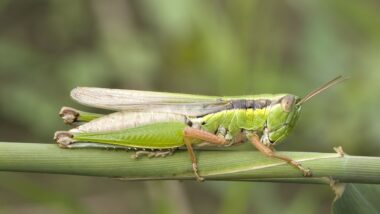
Pingback: How To Take Care of A Pet Grasshopper - Bug Bushel